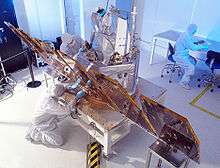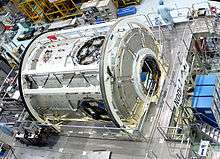Aerospace manufacturer
.jpg)


An aerospace manufacturer is a company or individual involved in the various aspects of designing, building, testing, selling, and maintaining aircraft, aircraft parts, missiles, rockets, and/or spacecraft. Aerospace is a high technology industry.
In the European Union, aerospace companies such as Airbus Group, BAE Systems, Thales, Dassault, Saab AB, and Leonardo-Finmeccanica are participants in the global aerospace industry and research effort.
In Russia, large aerospace companies like Oboronprom and the United Aircraft Corporation (encompassing Mikoyan, Sukhoi, Ilyushin, Tupolev, Yakovlev, and Irkut, which includes Beriev) are among the major global players in this industry.
In the United States, the Department of Defense and NASA are the two biggest consumers of aerospace technology and products. The Bureau of Labor Statistics of the United States reported that the aerospace industry employed 444,000 wage and salary jobs in 2004, many of which were in Washington and California, this marked a steep decline from the peak years during the Reagan Administration when total employment exceeded 1,000,000 aerospace industry workers.[1] During that period of recovery a special program to restore U.S. competitiveness across all U.S. industries, Project Socrates, contributed to employment growth as the U.S. aerospace industry captured 72 percent of world aerospace market. By 1999 U.S. share of the world market fell to 52 percent. Leading companies like Boeing, United Technologies Corporation and Lockheed Martin are among the most widely known aerospace manufacturers in the world. The General Electric Company, is the largest of all commercial aerospace companies with revenues of US$146,045 million reported in FY2014 while second- and third-largest aerospace companies are Boeing Company and Airbus Group with revenues of US$86,623 million and US$78,662 million respectively in FY2014.[2]
Important locations of the civil aerospace industry worldwide include Seattle, Wichita, Kansas, Dayton, Ohio and St. Louis in the United States (Boeing), Montreal and Toronto in Canada (Bombardier, Pratt & Whitney Canada), Toulouse in France and Hamburg in Germany (Airbus, EADS), the North-West of England and Bristol in Britain (BAE Systems, Airbus and AgustaWestland), Komsomolsk-on-Amur and Irkutsk in Russia (Sukhoi, Beriev), Kiev and Kharkiv in Ukraine (Antonov), Nagoya in Japan (Mitsubishi Heavy Industries Aerospace and Kawasaki Heavy Industries Aerospace), as well as São José dos Campos in Brazil where Embraer is based.
Several consolidations took place in the aerospace and defense industries over the last few decades. Between 1988 and 2010, more than 5,452 mergers & acquisitions with a total known-value of US$579 billion were announced worldwide.[3] The largest transactions include the merger of Boeing with McDonnell Douglas valued at US$13.4 billion in 1996,[4] Marconi Electronic Systems, a subsidiary of the General Electric Company plc, was acquired by British Aerospace for US$12.9 billion in 1999 merger[5] and was renamed BAE Systems, and Raytheon acquired Hughes Aircraft Company for $9.5 billion in 1997.
See also
- Aerospace
- Aviation accidents and incidents
- List of aircraft manufacturers
- List of spacecraft manufacturers
References
- ↑ Parker, Dana T. Building Victory: Aircraft Manufacturing in the Los Angeles Area in World War II, pp. 131-2, Cypress, CA, 2013.
- ↑ Leading Commercial Aerospace Companies Retrieved 27-06-2016
- ↑ "Statistics on Mergers & Acquisitions (M&A) - M&A Courses | Company Valuation Courses | Mergers & Acquisitions Courses". Imaa-institute.org. Retrieved 2013-08-17.
- ↑ "McDonnell Douglas Press Releases 96-317". Boeing.com. Archived from the original on 2013-06-15. Retrieved 2013-08-17.
- ↑ Archived March 10, 2011, at the Wayback Machine.
Further reading
- Hartley, Keith. The Political Economy Of Aerospace Industries: A Key Driver of Growth and International Competitiveness? (Edward Elgar, 2014); 288 pages; the industry in Britain, continental Europe, and the US with a case study of BAE Systems.
- Newhouse, John. The Sporty Game: The High-Risk Competitive Business of Making and Selling Commercial Airliners. New York: Alfred A. Knopf, 1982. ISBN 978-0-394-51447-5.
External links
- Aerospace Industries Association
- Associação das Indústrias Aeroespaciais do Brasil (Aerospace Industries Association of Brazil) (Portuguese)